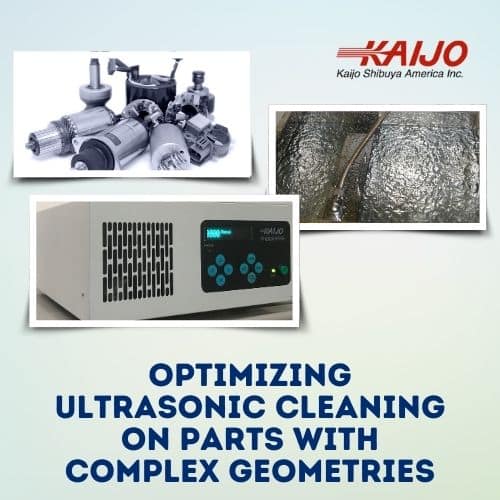Optimizing Ultrasonic Cleaning on Parts with Complex Geometries
Written by: Michael Danese | January 21, 2025
 Precision and efficiency are critical in manufacturing, especially when dealing with parts that feature intricate designs or hard-to-reach areas. Ultrasonic cleaning systems have become an indispensable tool in this space, offering a reliable and effective way to maintain cleanliness and quality across various industries.
Precision and efficiency are critical in manufacturing, especially when dealing with parts that feature intricate designs or hard-to-reach areas. Ultrasonic cleaning systems have become an indispensable tool in this space, offering a reliable and effective way to maintain cleanliness and quality across various industries.
Precision cleaning is non-negotiable in semiconductors, medical devices, and automotive manufacturing industries, where product performance depends on meeting strict quality standards. Cleaning intricate designs with hard-to-reach crevices presents a challenge that traditional methods—such as manual scrubbing, spray washing, or chemical soaking—cannot reliably solve. These outdated techniques often leave behind residue, risking contamination and reduced functionality.
Kaijo’s advanced ultrasonic cleaning technology provides a solution by harnessing the power of ultrasonic waves to perform thorough and consistent cleaning. This innovative system utilizes high-frequency sound waves to remove even the most challenging contaminants from complex geometries with unmatched accuracy. Whether you’re working with circuit boards, delicate medical tools, or industrial machine parts, ultrasonic cleaning ensures thorough results while improving efficiency and eliminating the inefficiencies of manual labor.
Why Ultrasonic Cleaning Is the Perfect Solution for Complex Geometries
Cleaning parts with intricate designs, tight crevices, or irregular surfaces can be a significant challenge for manufacturing operations. Traditional cleaning methods, such as manual scrubbing, spray washing, or chemical soaking, often fail to deliver thorough results. They may leave contaminants in hard-to-reach areas, risk damaging delicate materials, or require excessive time and labor.
Ultrasonic cleaning systems solve these challenges using high-frequency ultrasonic waves to create microscopic cleaning bubbles. This cavitation process dislodges contaminants from tight crevices or irregular surfaces with remarkable precision, ensuring thorough cleaning without labor-intensive methods. It provides precision and consistency across every cleaning application, making it an essential tool for industries demanding high-quality results.
Key Advantages of Ultrasonic Cleaning for Complex Applications
- Precision Cleaning for Complex Parts: Ultrasonic waves effectively remove oils, residues, and microparticles from tight areas without damaging the surface. This level of precision is critical for maintaining consistent quality and ensuring optimal performance of parts.
- Uniform Results Across All Applications: Unlike manual or less advanced methods, ultrasonic cleaning delivers consistent results regardless of a part’s shape or size. This eliminates variability and ensures each component meets strict cleanliness standards.
- Reduced Time and Costs: Automating the cleaning process reduces cycle times, minimizes the need for manual labor, and lowers overall operational costs. This leads to increased production efficiency and streamlined workflows.
- Gentle yet Effective Cleaning: For fragile components, such as optical lenses or semiconductor wafers, ultrasonic systems clean thoroughly without scratching or degrading delicate materials.
Tailored for Complex Geometries
Parts with intricate geometries—such as circuit boards, medical instruments, or components with deep cavities—pose unique cleaning challenges. Ultrasonic cleaning technology is specifically engineered to address these obstacles:
- Reaches Hidden Areas: The cavitation process ensures thorough cleaning in areas that traditional methods cannot access, leaving no contaminants behind.
- Adaptable to Many Materials: Ultrasonic cleaning is adaptable to different materials and contamination levels, from stainless steel machine parts to ceramic medical devices.
- Scalable Operations: Cleans small parts in batches or large components individually based on the application.
By addressing the challenges of cleaning complex geometries with precision, consistency, and efficiency, ultrasonic cleaning systems help achieve operational excellence while maintaining the highest product quality standards.
How Ultrasonic Cleaning Works
The power behind ultrasonic cleaners lies in the science of high-frequency sound waves and their interaction with cleaning solutions. This advanced technology removes contaminants effectively while protecting the structural integrity of intricate or delicate parts.
At its core, ultrasonic cleaning operates through a process called cavitation:
- Ultrasonic Frequencies: High-frequency sound waves, typically ranging from 20 kHz to 200 kHz, are generated by an ultrasonic transducer. The sound waves are transmitted through a cleaning solution.
- Cavitation Process: The sound waves create millions of microscopic bubbles in the cleaning liquid. These bubbles rapidly form and collapse, releasing bursts of energy that dislodge contaminants from surfaces, including tight crevices and hard-to-reach areas.
- Cleaning Solution: A specialized liquid, often water combined with mild detergents or cleaning agents, enhances the cavitation effect, ensuring maximum dirt and residue removal.
The Role of Ultrasonic Cleaning Tanks
Ultrasonic cleaning tanks are integral to the process, serving as the environment where cleaning takes place:
- Transducers: Mounted on the tank’s walls or immersed in the solution, transducers convert electrical energy into ultrasonic waves, which initiate the cavitation process.
- Part Placement: Components are submerged in the cleaning tank, where the ultrasonic waves effectively clean every visible and hidden surface. Fixtures or baskets may be used to organize parts and promote even cleaning.
Why It’s Effective
This method ensures contaminants—such as oils, grease, dirt, or microscopic debris—are dislodged without abrasives or harsh chemicals. Whether dealing with rugged machine parts or delicate semiconductor wafers, ultrasonic cleaning technology offers a thorough, non-damaging solution that works across a wide range of materials and geometries.
Essential Factors for Optimizing Ultrasonic Cleaning
Achieving the best results with ultrasonic cleaning systems requires a tailored approach to match the specific materials, contaminants, and geometries being cleaned. Factors like frequency, power, and cleaning solution choice significantly impact performance. Below are the essential elements to consider for optimizing ultrasonic cleaning:
- Selecting the Correct Frequency
Frequency is critical to balance cleaning strength and material protection.
- Lower Frequencies (20–40 kHz): Best for cleaning durable parts made of harder metals and materials with heavy contamination, such as automotive and industrial components. The larger cavitation bubbles created at lower frequencies provide intense cleaning action to remove grease, oil, and grime.
- Mid-Range Frequencies (60–200 kHz): Suited for cleaning less robust parts and softer metals and materials, like aluminum, LCDs, medical instruments, and circuit boards. Mid-range frequencies create bubbles that deliver gentler cleaning, ensuring the part’s surface remains intact.
- High Frequencies (430 kHz-2MHz+): Provides precise cleaning of delicate parts and very soft materials, like semiconductor wafers, electronic components, and delicate medical instruments. High frequencies create the smallest bubbles that deliver very gentle and precise cleaning to ensure delicate parts are not damaged.
Choosing the right frequency based on materials ensures contaminants are removed safely and effectively.
- Adjusting Power Settings
Power output dictates the cleaning intensity:
- High Power: Ideal for sturdy items that need intense cleaning to remove tough debris or buildup.
- Low Power: Ensures delicate components are cleaned effectively without risking damage caused by excessive vibration energy.
Adjustable power settings allow manufacturers to fine-tune cleaning intensity for specific parts and applications.
- Choosing the Right Cleaning Solution
Cleaning solutions should enhance cavitation and match the contaminants:
- Grease and Heavy Oils: Use alkaline or degreasing solutions that break down tough residues.
- Microscopic Particles and General Contaminants: Neutral or mild detergents are effective for sensitive materials such as ceramics, silicon wafers, and optical components.
The cleaning solution must also be compatible with the material to avoid corrosion or unwanted chemical reactions.
- Material-Specific Considerations: Sturdy vs. Delicate Parts
Ultrasonic cleaning systems are versatile enough to handle both sturdy and fragile components, but their settings must be adjusted to the material type:
- For Heavy-Duty Parts: Low-frequency and high-power settings are suitable for removing robust contaminants from durable materials like stainless steel or industrial tools.
- For Fragile Components: High-frequency, low-power settings ensure safe and effective cleaning of delicate surfaces, such as medical tools or electronic components.
Optimizing these factors ensures thorough, safe, and efficient cleaning, reducing labor and maintaining high-quality results for any application.
Steps for Enhancing Cleaning Effectiveness
Specific best practices can improve cleaning precision, consistency, and efficiency to maximize the performance of ultrasonic cleaning systems. These steps ensure thorough cleaning while protecting the integrity of the components.
- Proper Placement of Parts in the Cleaning Tank
Positioning parts correctly in the ultrasonic cleaning tank is crucial to achieving even cleaning. Components should avoid overlapping or touching, which could create “shadow areas” where ultrasonic waves are less effective.
- For intricate designs, orient parts so hard-to-reach areas are exposed to the cleaning solution.
- Space parts evenly to allow for optimal cavitation across all surfaces.
- Utilize Fixtures or Baskets
Using baskets or custom fixtures can ensure parts remain in the proper orientation during cleaning, improving consistency. Fixtures also prevent delicate parts from moving within the tank, reducing the risk of damage.
- Optimize Cleaning Cycle Times
Determine the appropriate cleaning time based on the level of contamination and part material:
- Shorter Cycles: Adequate for lightly soiled components to reduce cleaning time and energy consumption.
- Longer Cycles: Necessary for stubborn contaminants, but avoid excessive durations to maintain efficiency.
Regularly evaluate cycle times to balance thorough cleaning with production speed.
- Adjust Frequency and Power Appropriately
Matching ultrasonic frequency and power settings to the part’s material is essential. For delicate items, higher frequencies with lower power settings avoid surface damage. For robust hard materials, lower frequencies with higher power increase cleaning effectiveness.
Benefits for Engineers and Manufacturers with Kaijo’s Phenix Series
Kaijo’s Phenix Series Ultrasonic Systems, including the Phenix+ and Phenix Hyper, are designed to address the unique cleaning challenges modern industries face. These systems combine advanced technology with reliability, providing precise and efficient cleaning for intricate and large-scale applications.
- Precision Cleaning for Complex Geometries
The Phenix Series ensures contaminants are thoroughly removed from hard-to-reach areas without damaging delicate parts. Whether cleaning intricate circuit boards or fragile medical tools, these systems deliver consistent results with unmatched accuracy.
- Customizable Features
The Phenix+ and Phenix Hyper offer adjustable power and frequency settings that can be fine-tuned for a wide range of materials and contaminants. This flexibility allows manufacturers to optimize cleaning for robust industrial parts and delicate components like semiconductors or optical lenses.
- Enhanced Productivity
Kaijo’s Phenix Series systems reduce manual labor, shorten cleaning cycle times, and increase throughput by automating the cleaning process. This streamlines workflows and enables manufacturers to meet production demands efficiently.
- Durable and Reliable Design
Engineered for long-term performance, the Phenix+ and Phenix Hyper systems require minimal maintenance, reducing downtime and ensuring consistent operation for critical cleaning tasks.
- Cost Efficiency
Kaijo’s Phenix Series ultrasonic systems lower operating costs by minimizing waste, extending the lifespan of critical parts, and reducing the need for rework. This makes these systems a valuable investment for improving manufacturing efficiency while maintaining high-quality standards.
Conclusion and Next Steps
Ultrasonic cleaning systems provide an unbeatable solution for industries with the challenges of cleaning intricate geometries and sensitive components. By leveraging advanced technology, Kaijo’s systems ensure precision, consistency, and efficiency across a wide range of applications. Whether removing stubborn contaminants, improving throughput, or ensuring delicate parts remain undamaged, their solutions are designed to help manufacturers achieve operational excellence.
Kaijo’s Phenix+ and Phenix Hyper Ultrasonic Systems are reliable, customizable, and cost-effective tools for tackling even the most complex cleaning tasks. Their ability to optimize the balance between power, frequency, and material-specific requirements highlights Kaijo’s commitment to delivering superior results.
If you’re looking for a way to streamline your cleaning processes while maintaining the highest quality standards, Kaijo has the expertise and technology to help. Contact Kaijo today for a free consultation to see how ultrasonic cleaning can reduce costs and improve your cleaning results.





